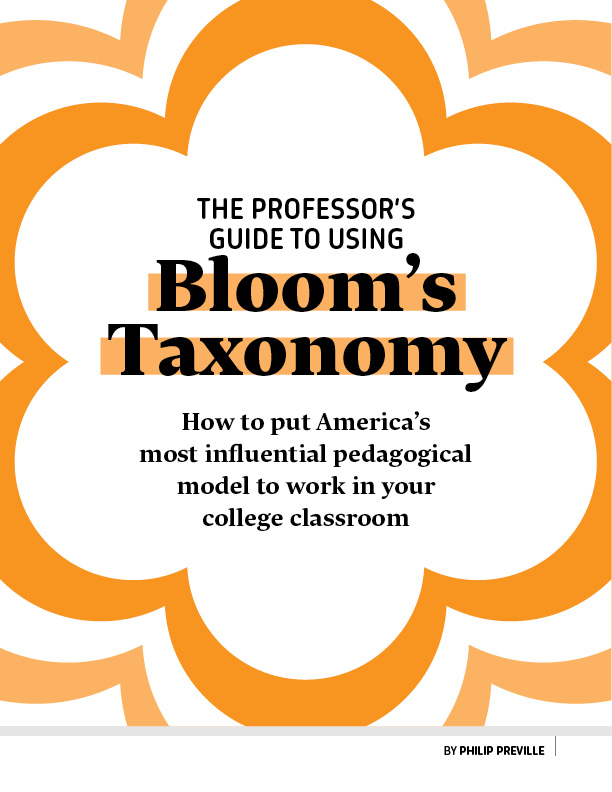What are Bloom’s taxonomy words? Although Bloom’s taxonomy was first created over fifty years ago, the words — and the updated learning objectives in the revised version — are still relevant, because they were chosen carefully to show progression from basic understanding, through several levels of student learning, to eventual mastery.
Bloom’s taxonomy still plays an important and active part in the modern classroom. So, how does it work, what are the six levels of complexity and why does it focus on so many verbs?
From a passive to an active framework
In 2001, a group of cognitive psychologists, curriculum theorists, instructional researchers and testing assessment specialists revised Bloom’s taxonomy by putting together a series of more dynamic concepts for the classification system versus the original static, one-dimensional levels of learning objectives.
The Bloom’s taxonomy words were changed from nouns to verbs—providing learners with clearer objectives for what is expected of them. What’s more, the most important two levels, ‘evaluate’ and ‘create’, were swapped to make creation the main goal of learning.
| Older version | Revised Bloom’s taxonomy |
| Knowledge | Remember |
| Comprehension | Understand |
| Application | Apply |
| Analysis | Analyze |
| Synthesis | Evaluate |
| Evaluation | Create |
The rest of this post deals with the revised version of Bloom’s taxonomy, as this is the one in general classroom usage.
The revised Bloom’s taxonomy words in practice
Bloom’s taxonomy is hierarchical. Students must achieve each objective in succession through the six levels of complexity: remember, understand, apply, analyze, evaluate then create. Some activities are in grey areas, and some curriculums don’t fit cleanly into these boxes.
However, the basic principle is this: In order to understand a concept, you must remember it; to apply a concept you must first understand it. In order to evaluate a process, you must have analyzed it; and to create something new, you must have evaluated the possibilities first.
Bloom’s taxonomy aims to address how students can bridge the learning gap between what they know already, and where they need to be. Each of the six levels of complexity contains several words, some repeated, that are actions.
Crucially, all the Bloom’s taxonomy words are measurable; there is no conceptual measurement of “know” or “learn”, but you can either cite, explain, or summarize a concept successfully—or not.
This structure ensures that students have a clear and concise understanding of what they need to accomplish by the end of the lecture, and each instructor is able to direct their teaching and learning strategies towards improving their classroom’s higher order thinking skills.
The Bloom’s Taxonomy words as they apply to the six levels: a chart
| Remember | Understand | Apply | Analyze | Evaluate | Create |
| Cite | Clarify | Construct | Classify | Assess | Categorize |
| Define | Compare | Demonstrate | Compare | Conclude | Construct |
| Describe | Describe | Determine | Explain | Determine | Develop |
| Identify | Discuss | Discover | Identify | Interpret | Formulate |
| Outline | Explain | Express | Investigate | Predict | Incorporate |
| Recall | Predict | Investigate | Outline | Support | Reconstruct |
| Recognize | Summarize | Predict | Relate | Validate | Summarize |
Here’s how to apply the words in each level. After you decide your learning outcomes, you can break them down further into lecture learning outcomes. These are statements of what learners will be able to perform in a segment of learning, and they need to have the following three pillars:
- Condition (often the resources being used)
- Performance (what they hope students will be able to accomplish by the end)
- Criteria (how will they know the student has succeeded)
However, while condition and criteria are pretty straightforward, the biggest pitfall for educators is making the performance actionable and effective. In order to be actionable the professor needs to have a specific verb that sets clear expectations for what the student must achieve to be successful—and this is where the Bloom’s taxonomy words shine.
Armed with these words, you can also plan activities and tasks around them. Assessing remembering and understanding can be done with straightforward tasks such as in-class multiple choice questions; the highest levels of Bloom’s, evaluation and creation, might best be assessed through an essay or group work. Choosing which kind of activity is appropriate for evaluating each stage can be done with some practice and forethought.
Conclusion
Read our full, comprehensive guide to Bloom’s taxonomy to learn more about its history and application in active learning, and some of the problems educators have identified with it.
You can also download our professor’s handbook on Bloom’s taxonomy, which features interviews with educators on how they implemented Bloom’s taxonomy words and actions, as well as classroom planning worksheets, by filling in the form below.
Related story
More on Bloom’s and the knowledge domension in the cognitive domain of learning

Get the professor perspective of Bloom’s taxonomy with our guide
Download our free e-book to more real-life techniques for helping students set expectations for themselves, ways to set and deliver on specific course learning objectives, and tool kits for activity planning and assessment.
Fill in the simple form below for instant access.


